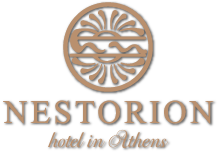The Acropolis Museum
the budget hotel in athens
The Acropolis Museum was founded to exhibit all the significant finds from the Sacred Rock and its foothills. It was designed by architect Bernard Tschumi with Michael Photiadis and inaugurated in the summer of 2009.
The Museum is located in the historic Makryianni district, situated 3000 meters south of the Acropolis. It is approximately 2 kilometers away from the center of Athens and conveniently located next to the Acropolis Metro Station. The museum s main entrance is located at the beginning of Dionysiou Aeropagitou Street, a pedestrian walkway that forms the central axis within the unified network of the city s archaeological sites.
The Architecture:
The Acropolis Museum covers a total area of 25.000 square meters of which over 14.000 square meters is exhibition space. The architectural form of the museum was dictated by three major requirements: It was necessary to maintain visual contact with the monuments of the Acropolis; to exhibit the Parthenon sculptures in their entirety and to adapt the building to the archaeological excavation that extends across the foundations.
The visual link between the Parthenon sculptures exhibited in the Museum and the monument from which they originated is achieved through the transparent, glass outer walls of the Parthenon Gallery, the visitor is treated to a breathtaking view of Acropolis, the surrounding historic hills and the modern city of Athens.
Inside the Parthenon Gallery, a rectangular, solid, concrete core was built to the same dimensions and orientation as the Parthenon. It was specially to receive and display the entire temple frieze.
At its base, the Museum appears to be floating, as it is supported by more than1000 concrete pillars which provide an impressive shelter for the site s archaeological excavation.
The Museum hosts its collections across three levels, as well as in the archaeological excavation that lies at its foundations.
Located on the ground floor, the Gallery of the Slopes of the Acropolis, houses finds from the sanctuaries that were established on the slopes of the Acropolis, as well as objects that Athenians used in everyday life from all historic periods.
The nine-meter high, naturally lit Archaic Gallery in the east and south sections of the first floor, hosts the magnificent sculptures that graced the first temples on the Acropolis. It is also displays the votive offerings dedicated by the worshippers, such as the beautiful archaic korai (depictions of young women), the Hippies (horse riders), statues of the Goddess Athena, sculptures of male figures, marble reliefs, and smaller bronze and clay offerings.
The Museum s exhibition culminates on the third floor, in the grass-encased Parthenon Gallery. The relief sculptures of the Parthenon frieze depicting the Panathenaic procession are exhibited in continuous sequence along the perimeter of the external surface of the rectangular concrete core of the Gallery. The metopes, the marble slabs with relief representations from Greek mythology, are exhibited in between the stainless steel columns of the Gallery, which are the same in number as the columns of Parthenon. The colossal figures of the two pediments have been placed on the pedestals on the east and west sides of the Gallery. The east pediment depicts the birth of the Goodness Athena, emerging from the head of her father Zeus, and the west pediment depicts the battle between Athena and Poseidon over the land of Attica.
Having seen the Parthenon Gallery, the visitor can then return to the first floor to complete the tour with the series of works that were created after the construction of the Parthenon, namely the Propylaia, the temple of Athena Nike and the Erechtheion. The north wing of the first floor displays striking Classical sculptures and their Roman copies, as well as a votive and decree reliefs dating to the 5th and 4th centuries BC, relief bases of sculptures and prtraits, and finally, select works dating from the end of antiquity and the early Byzantine period.
The Museum s exhibition program is also enriched with the extensive finds from the ancient Athenian city which were uncovered during the archaeological excavation of the Museum. The excavation that took place prior to the construction of the Museum. The excavation is visible from different points on the ground and upper floors of the Museum, through series of well positioned large glass openings. Visitors will soon be able to walk among the remains of this ancient Athenian neighborhood.
http://www.theacropolismuseum.gr/el/content/hrisimes-plirofories
The Museum is located in the historic Makryianni district, situated 3000 meters south of the Acropolis. It is approximately 2 kilometers away from the center of Athens and conveniently located next to the Acropolis Metro Station. The museum s main entrance is located at the beginning of Dionysiou Aeropagitou Street, a pedestrian walkway that forms the central axis within the unified network of the city s archaeological sites.
The Architecture:
The Acropolis Museum covers a total area of 25.000 square meters of which over 14.000 square meters is exhibition space. The architectural form of the museum was dictated by three major requirements: It was necessary to maintain visual contact with the monuments of the Acropolis; to exhibit the Parthenon sculptures in their entirety and to adapt the building to the archaeological excavation that extends across the foundations.
The visual link between the Parthenon sculptures exhibited in the Museum and the monument from which they originated is achieved through the transparent, glass outer walls of the Parthenon Gallery, the visitor is treated to a breathtaking view of Acropolis, the surrounding historic hills and the modern city of Athens.
Inside the Parthenon Gallery, a rectangular, solid, concrete core was built to the same dimensions and orientation as the Parthenon. It was specially to receive and display the entire temple frieze.
At its base, the Museum appears to be floating, as it is supported by more than1000 concrete pillars which provide an impressive shelter for the site s archaeological excavation.
The Museum hosts its collections across three levels, as well as in the archaeological excavation that lies at its foundations.
Located on the ground floor, the Gallery of the Slopes of the Acropolis, houses finds from the sanctuaries that were established on the slopes of the Acropolis, as well as objects that Athenians used in everyday life from all historic periods.
The nine-meter high, naturally lit Archaic Gallery in the east and south sections of the first floor, hosts the magnificent sculptures that graced the first temples on the Acropolis. It is also displays the votive offerings dedicated by the worshippers, such as the beautiful archaic korai (depictions of young women), the Hippies (horse riders), statues of the Goddess Athena, sculptures of male figures, marble reliefs, and smaller bronze and clay offerings.
The Museum s exhibition culminates on the third floor, in the grass-encased Parthenon Gallery. The relief sculptures of the Parthenon frieze depicting the Panathenaic procession are exhibited in continuous sequence along the perimeter of the external surface of the rectangular concrete core of the Gallery. The metopes, the marble slabs with relief representations from Greek mythology, are exhibited in between the stainless steel columns of the Gallery, which are the same in number as the columns of Parthenon. The colossal figures of the two pediments have been placed on the pedestals on the east and west sides of the Gallery. The east pediment depicts the birth of the Goodness Athena, emerging from the head of her father Zeus, and the west pediment depicts the battle between Athena and Poseidon over the land of Attica.
Having seen the Parthenon Gallery, the visitor can then return to the first floor to complete the tour with the series of works that were created after the construction of the Parthenon, namely the Propylaia, the temple of Athena Nike and the Erechtheion. The north wing of the first floor displays striking Classical sculptures and their Roman copies, as well as a votive and decree reliefs dating to the 5th and 4th centuries BC, relief bases of sculptures and prtraits, and finally, select works dating from the end of antiquity and the early Byzantine period.
The Museum s exhibition program is also enriched with the extensive finds from the ancient Athenian city which were uncovered during the archaeological excavation of the Museum. The excavation that took place prior to the construction of the Museum. The excavation is visible from different points on the ground and upper floors of the Museum, through series of well positioned large glass openings. Visitors will soon be able to walk among the remains of this ancient Athenian neighborhood.
http://www.theacropolismuseum.gr/el/content/hrisimes-plirofories




















































